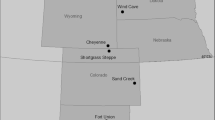Abstract
Recent research suggests that increases in growing-season length (GSL) in mid-northern latitudes may be partially responsible for increased forest growth and carbon sequestration. We used the BIOME-BGC ecosystem model to investigate the impacts of including a dynamically regulated GSL on simulated carbon and water balance over a historical 88-year record (1900–1987) for 12 sites in the eastern USA deciduous broadleaf forest. For individual sites, the predicted GSL regularly varied by more than 15 days. When grouped into three climatic zones, GSL variability was still large and rapid. There is a recent trend in colder, northern sites toward a longer GSL, but not in moderate and warm climates. The results show that, for all sites, prediction of a long GSL versus using the mean GSL increased net ecosystem production (NEP), gross primary production (GPP), and evapotranspiration (ET); conversely a short GSL is predicted to decrease these parameters. On an absolute basis, differences in GPP between the dynamic and mean GSL simulations were larger than the differences in NEP. As a percentage difference, though, NEP was much more sensitive to changes in GSL than were either GPP or ET. On average, a 1-day change in GSL changed NEP by 1.6%, GPP by 0.5%, and ET by 0.2%. Predictions of NEP and GPP in cold climates were more sensitive to changes in GSL than were predictions in warm climates. ET was not similarly sensitive. First, our results strongly agree with field measurements showing a high correlation between NEP and dates of spring growth, and second they suggest that persistent increases in GSL may lead to long-term increases in carbon storage.
Similar content being viewed by others

Author information
Authors and Affiliations
Additional information
Received: 26 May 1998 / Accepted: 6 July 1998
Rights and permissions
About this article
Cite this article
White, M., Running, S. & Thornton, P. The impact of growing-season length variability on carbon assimilation and evapotranspiration over 88 years in the eastern US deciduous forest. Int J Biometeorol 42, 139–145 (1999). https://doi.org/10.1007/s004840050097
Issue Date:
DOI: https://doi.org/10.1007/s004840050097



